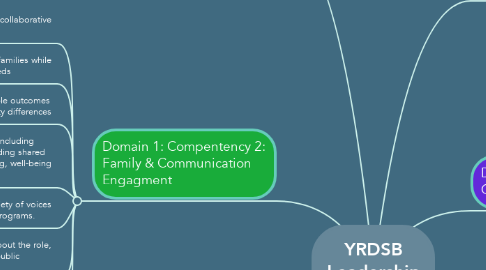YRDSB Leadership Framework
by Todd Taylor

1. Domain 1: Competency 1: Personal & Interpersonal Capacity
1.1. Self awareness and regulation around how identifies assumptions and bias affect leadership
1.2. Engage in actions and communications that model trust.
1.3. Build collaborative, production and professional relationships with key stakeholders
1.4. Engage in co-learning for improvement
1.5. Support others in their learning and growth
2. Domain 1: Compentency 2: Family & Communication Engagment
2.1. Co-create an develop collaborative cultures
2.2. Visible and accessible to families while reflecting their diverse needs
2.3. Working to ensure equitable outcomes while respecting community differences
2.4. Demonstrate awareness of including community expertise in building shared solutions for student learning, well-being and achievement.
2.5. Seek out and engage a variety of voices when building policy and programs.
2.6. Transparent communication about the role, rights and responsibilities of public education
2.7. Ensure SIP planning reflects community input.
3. Domain 2: Competency 3: Indigenous Knowledge & Education
3.1. Engage in learning to understand intersectionality and how that impacts relationships
3.2. Ensuring Indigenous perspectives are consulted and included in decision making.
3.3. Review the TRC recommendations, in an effort to build empathy, understanding and respect
3.4. Create spaces to hear Indigenous voices as a system leader.
3.5. Apply Indigenous learnings to system work.
4. Domain 2: Competency 4: Anti Racism & Anti Oppression
4.1. Ensuring alignment between school based decisions and relevant Human Rights law.
4.2. Understand and lead the work for anti-oppression
4.3. Identify and remove structural barriers that exist within our system for the ultimate well being of all
4.4. Understanding all stakeholders are accountable to creating culturally responsive practices.
5. Domain 3: Competency 5: Instructional Practice
5.1. Collaborative methods to lead learning that is based in current pedagogy, assessment practices and equity.
5.2. Understanding and ensure responsibile administration of Special Ed Policies and Procedures
5.3. Create enviroments where questions are encourage and co-construct shared understandings.
5.4. Educational leadership that results in achieving all learner's needs, but especially underserved and under performing
5.5. Leaders promote reflection about teaching and learning to measure impact.
6. Domain 3: Competency 6: Culturally Responsive Practice
6.1. Understand and work to change sociocultural structures that impact people.
6.2. Understand and apply CRRP
6.3. Ensuring that approaches when working with familes are responsive and reflective
6.4. Hire and develop staff who engage in CRRP
7. Domain 4: Competency 7: Governance & Strategic Planning
7.1. Work effectively within existing structures of Public Education
7.2. Develop and maintain effective relationships with School Council and Trustee
7.3. Use data to inform decision making, leadership decisions and goal setting
7.4. Planning, monitoring and implementing the SIP
8. Domain 4: Compentency 8: Human Resource Management & Financial Stewardship
8.1. Ensure actions align with relevant agreements and legislation.
8.2. Foster development of school staff, in line with Board Priorities
8.3. Engage in growth oriented appraisal process that aline with the DAP
8.4. Share leadership opportunities to develop staff in a building
8.5. Build proficiency in ensuring buildings operate smoothly thru day-to-day duties
8.6. Ensure alignment of school resources with the DTAP, MYSP and other priorities


